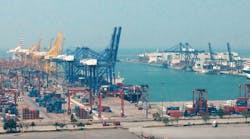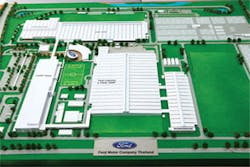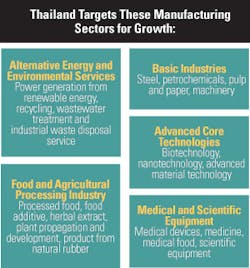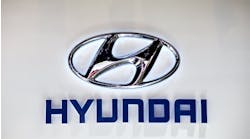Walk through an industrial estate just outside of Bangkok and you are surrounded by familiar global manufacturers such as Ford, General Motors and Toyota, alongside dozens of Asian-based companies. The brand new factories meld well with the ever-present religious shrines. As you tour the area, the overwhelming impression is that this did not happen by chance. This was all part of a plan -- a plan that is still unfolding.
See Also: Manufacturing Plant Site Location Strategies
A country of only 66 million people doesn't become the 17th largest global manufacturer without careful planning. Thailand is the second largest producer of light pick-up trucks. Carefully constructed strategies along with tangible incentives created this robust manufacturing economy.
Industrial Estates Speed Development
The linchpin of the strategy is a network of industrial estates that take a full value chain approach to manufacturing. These estates, run by private companies, have left no stone unturned in offering a turnkey location that takes into account the myriad manufacturing needs.
Not ready to build a factory yet? Not a problem. The industrial estate has already built factories that you can rent to own. Logistic parks are nearby, as are all forms of transportation. Financial incentives are available, combined with free trade zone status. And if that's not enough, one of the largest developers of factory estates, Amata Corp., is evolving its locations to create full-fledged communities that include schools, language labs, and even driving ranges.
These estates are administered by a division of the Ministry of Industry in a strategic industrialization plan designed to position Thailand favorably relative to its Southeast Asian competitors. For example, in neighboring countries a manufacturer cannot own land and must adhere to local content laws. Thailand has no such rules. And it offers other perks including corporate tax holidays, exemption from or reduction of import duties on machinery and materials, and permission to use technicians from home countries.
Proof that Thailand's careful planning is paying off is abundant. The country ranks 14th in the world in the production of automobiles, which accounts for 12% of the country's GDP. Employing 400,000, this sector accounts for $25 billion in exports (the third largest in the country). And the sector is growing at a good clip: Production totaled 2 million units last year and is expected to reach 2.5 million in 2013.
See Also: Images from Thailand [SLIDESHOW]
While all major Japanese automotive OEMs have a presence in the industrial estates around Bangkok, other OEMs including Ford (IW 500/6), GM (IW 500/4) and BMW (IW 1000/36) not only have plants but are expanding. Tier 2 and 3 suppliers are also expanding, including Dana Holding Co. (IW 1000/541), Bridgestone Corp. (IW 1000/113) and Denso Corp. (IW 1000/109).
To understand the extent of the supply chain for the automotive network, you need only look at the products manufactured in the Hemaraj Industrial Estates, one of the other large real estate development companies. There are over 154 auto-related manufacturers across this one company's industrial estates including: suspension, air conditioner, brake systems, wheel parts, exhaust systems, drive shafts and chassis parts. .
New Economic Market Coming
With the proliferation of the supply chain, Thailand has set the foundation to extend its reach.
"Thailand has been the automotive production hub for the Asia Pacific region, but is now growing into a global hub," Morio Owaki, vice president at Toyota (IW 1000/8) Asia Pacific Engineering and Manufacturing, told Thailand's Board of Investment, which operates under the Ministry of Industry and is the principal agency for encouraging investment in the country.
According to the Japan Automobile Manufacturers Association, the quality of the auto parts made in Thailand is the highest of any country in the Association of Southeast Asian Nations (ASEAN). The economic association includes Thailand, Singapore, Malaysia, Indonesia, the Philippines, Brunei, Cambodia, Laos, Myanmar and Vietnam.
In 2015 the association will become the ASEAN Economic Community (AEC), turning these countries into a single market and production base that will allow free movement of goods, services and skilled labor and free flow of capital.
"The potential of a combined market economy of 600 million consumers creating a $2 trillion economy through the AEC is why we are positioning Thailand as an 'Asian Hub,'" explains Ajarin Pattanapanchai, senior executive investment advisor for the Board of Investment.
"Our free market system combined with our many free trade agreements allow us to offer investors, and manufacturers in particular, a strong economic base from which to operater and have access to markets in Southeast Asia, " Pattanapancha added.
This potential growth created by the ACE is bringing increased investment from U.S. manufacturers. "As a part of American Axle & Manufacturing's (IW 500/310) strategic global growth plan, we set our sights on Thailand, the largest vehicle market in Southeast Asia," AAM President and CEO David C. Dauch told IndustryWeek.
The Thailand facility, which supplies front and rear axles as well as drive shafts for GM's midsize trucks, was established in 2011.
Dauch points out that his company has found many advantages associated with the Rayong provice of Thailand. "AAM's product line-up and core compentencies are a natural fit for the vehicles produced in the country," he added. "The centralized Southweastern region has a first-rate infrastructure with quality roads and highways along with the logistic benefits. AAM found a market competitive cost structure and a prospective pool of skilled manufacturing candidates."
Dauch told IndustryWeek that 'recently the company has earned additional business with a second global OEM," Dauch said.
"It is predicted that the ASEAN region will become the sixth-largest automotive market by 2018, mainly driven by the growth in Thailand and Indonesia," Dauch added.
But in order to be properly positioned as the hub of the region, Thailand recently had to address some critical supply chain issues, brought to the fore by the flood of 2011, which damaged more than 1,000 factories.
The computer hard drive industry in particular was severely affected by the floods. Since 2005 Thailand has supplied nearly half of the world's hard disk drives. Western Digital's (IW 500/109) factory in Bang, Pa., which produces one quarter of the world's supply of sliders, a component of hard disk drives, was flooded. It took 46 days until the water receded and three months until partial production could resume after the flood. A tour of this facility, where every piece had to be dismantled and cleaned, is not complete without a photo next to the high waterline on the outside factory wall.
"The efforts of our staff, who despite personal difficulties arrived daily in any manner possible to clean up the factory, was an amazing group accomplishment," Joe Bunyda Sr., vice president of HDD Operations, told tour participants.
The company, which employs 37,000 people at its two plants in Thailand, has made a number of changes both physically at the plant and within its distribution system to ensure that the supply chain disruption won't be repeated. At the plant there is now a 10-foot-high wall around the entire campus with essential equipment manufactured on the second floor. The company has also relocated some capacity across its manufacturing footprint to reduce overall risk.
Research Bolstered to Support Manufacturing
Not content to rest on its success in the auto manufacturing and computer component segments, which will continue to grow, the government is looking toward the future and making sure it is a major player in the high-value manufacturing sectors.
Walking through Thailand's National Science Park, home to 1,600 researchers supplied through 24 universities, again you feel the hand of planners. Aside from the architectural design, the level of collaboration and ambition is palpable.
The National Science and Technology Development Agency, which was established in 1991 under the Ministry of Science and Technology, has four research centers across the country as well as a center for technology management.
The reserach is organized under five platforms:
BIOTEC - Research in this division includes genomic technology and cell factory technology
MTEC - This area explores design and simulations materials as well as manufacturing and materials design and production.
NECTEC- The focus in this division is on sensor technology, knowledge engineering technology as well as information security technology.
NONTEC- Nanotechnology including nanocoating, nanoencapsulation and functional nanostructures are studies in this division.
TMC- This division explores technology transfer and commercialization of discoveries and technologies.
Inside the Organic and Printed Electronics Innovation Center, located at the Thailand Science Park near Bangkok, researchers demonstrated some of the technologies that have commercial potential. One in particular -- OLED (Organic Light Emitting Diode) displays -- will serve a television market expected to reach $16 billion by 2020.
U.S. companies are on this campus in an effort to take advantage of the synergy available through multidisciplinary collaboration. Pfizer's (IW 500/17) recently spun-off division Zoetis, which develops products in the animal health sector, has a small lab located on the premises, as the parent company sees major growth in this sector. Air Products & Chemicals Inc. (IW 500/105) also has a large testing lab for customers, as Thailand is one of the world's leading food processing markets. The company's Asia Food Technology Center serves as a company Center of Excellence to help the Asian market.
In order to service these new industries, the government has committed to further building out its infrastructure. Recently the government approved a plan to spend $68 billion on a high-speed railway and other transportation mega-projects.
Thailand has six deep sea ports and two international river ports. Shipping capacity was recently expanded at the Laem Chabang Sea Port to 10.8 million TEUs (20-foot equivalent units), with an additional 8 million TEUs of expansion possible. This deep sea port is especially important, as it the hub of automotive shipments. The port has adjacent factory facilities, which are currently being used by the automobile industry.
Even with all of these business-friendly attributes, there are some business challenges. Judy Benn, executive director of the American Chamber of Commerce in Thailand, highlights custom issues. She suggests that companies need to be very careful in how they process their goods, ensuring that tariff classification is correct in order to avoid penalties and audits.
English proficiency presents some workforce concerns, but the real issue is the low level of unemployment: .7%. With industry expanding quickly, more workers will have to be found.
Political challenges include some instability in the southern part of the country. As Nuanjai Gittisriboongul, a partner at Deloitte Touche Tohmatsu explains, "Thailand has to make sure that is doesn't have any more political rallies and civil unrest."
The government is well aware of all of these issues and is working on them, as well as devising policies to lead growth in the future, explains Gittisriboongul.
In April the government announced that it would alter its incentive system for businesses. One of the biggest changes in the incentive structure is that financial assistance will no longer be based on the geographical zones that were set up in the industrial estates, but instead will be targeted toward developing new regional manufacturing clusters.
The planners are moving away from activities that have low technology, low value-added output, less complex production process, low linkage with other industry and labor-intensive production. Also included in the remove list are activities that have high energy consumption and create environmental problems.
These new policies are in keeping with a country that wants to ensure that its strong manufacturing base will lead, not follow, in the continuing evolution of the region's manufacturing strength.
For more on Thailand's manufacturing industry growth, click here.






